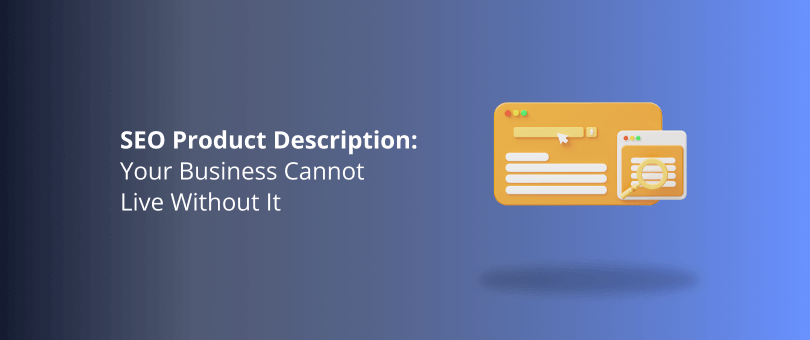Want to boost your eCommerce sales? Well-optimized product descriptions can seriously help.
Honestly, in 2023 eCommerce is too crowded and your business cannot live without SEO. Whether you’re new to it or want to step up your product page game, using keywords naturally, highlighting products’ benefits and optimizing for mobile is no longer optional. This is how you get more visits, more conversions, and more cash.
In this article, we’ll be sharing what SEO can do for your product descriptions and how to keep it simple.
Now, let’s dive in and make those product pages selling machines!
Readers Also Enjoy: Keyword Mapping for SEO: The Ultimate Guide – DevriX
What Is SEO Product Description?
Many people believe that it is enough to craft an inviting copy to sell your products. And while a good product description does more than just provide shoppers extra info and inspiration, in today’s world it’s not enough anymore.
You need to customize your product descriptions so that your target customers can find them. This means ensuring the copy aligns with your brand voice while serving the needs of potential customers and ranking high.
How to Write a Proper SEO Product Description?
Writing descriptions that score SEO points means that you first need to figure out what shoppers are searching for. This is what is called “search intent.”
Usually people do online searches for three main reasons: To learn, to buy, and to get inspiration. So your product description needs to match their intent.
No sweat if SEO writing is new to you, here is a clear guide to follow:
Perform Keywords Research
Do keywords research first. See what terms people are looking for. Tools like Semrush, Ubersuggest, Keywords Everywhere and WordStream are great for this. They show monthly searches and difficulty to rank.
Pick your target keywords. These are the specific words and phrases that align best with what potential customers are searching for.
Include Primary Keywords in the Title
Your primary keyword(s) is the main idea you want to rank for. For example, if you sell gym equipment your primary keywords might be “fitness tracker”.
Focus on User Search Intent in Description
Understand what motivates potential customers. Then describe how the product fulfills their needs or solves their problems.
Taking the fitness tracker example, you could emphasize how it helps users monitor activity levels and fitness goals.
Keep an Eye on the Product Description Length
There’s no ideal word count that universally ranks well. You have to tailor the description lengths of your products to what your audience needs. Different buyer personas will want varying levels of detail.
Generally 300 words it’s considered a short description but don’t feel obligated to fluff to hit some magical number! Write for your customers. Meet their info needs. And Google will reward you for such useful content!
Give Priority to Benefits not Features
People don’t need to understand everything about the features. What matters most is how your product improves their life. Focusing on the benefits is what motivates them to buy it.
Here is the classical “umbrella” example distinguishing both:

In your product descriptions, you need to include the following:
- Benefits. How exactly do the products help the customer? Focus on tangible improvements.
- Features. What does the product do? Highlight the most useful capabilities.
- Pricing. Be clear about your offers.
- Comparison to alternatives. What makes your product superior?
- Instructions. How is it used? Educate customers.
Readers Also Enjoy: How to Pick the Right Keywords for Your Content – DevriX
Craft Catchy Title Tags and Meta Descriptions
Title tags are crucial to clicks and SEO. Use 5-10 words with keywords up front. Be specific and descriptive. Avoid generic terms like “best seller”. Include those that describe the product’s purpose and functionality.
Meta descriptions summarize the page for searchers. Keep them 150-160 characters to prevent truncation. Don’t repeat the same title tag keywords across all product pages. Mix it up so pages get matched to diverse searches.
Compelling title tags and meta descriptions optimize click-through-rates and relevancy. Make them keyword-rich but also enticing and unique.
Avoid Keyword Stuffing
Never forget that your goal is persuading customers, not gaming algorithms.
Use your keywords as naturally as possible.
When you have a short product description it’s easy to not overuse keywords. Use your primary keyword once in the page’s URL, once in the product description title, once or twice in the body, and once in the alt image tag.
Longer descriptions can be riskier. Keyword stuffing them can backfire. Over-optimizing hurts SEO and conversion. Avoid it by:
- Keeping copy conversational. Don’t pack it with repetitive keywords.
- Using terms once or twice max. Otherwise it can look spammy.
- Focusing on providing engaging value. Value vs. ranking keywords.
Use Unique Descriptions for Each Product Page
Avoid duplicate copies of descriptions across products. Write custom descriptions tailored to each product page. Duplicate content can negatively impact SEO.
On eCommerce sites, duplicate content often stems from:
- Copied Product Descriptions. If you take manufacturer provided descriptions word-for-word without customizing, that’s duplicate content. Rewrite to differentiate.
- Copied Product Images. Using the exact same images as everyone else will not help you stand out. Use your own visual assets.
- Parameterized URLs. URLs with variables like product-123, product-456 can spawn thin duplicate pages. Consolidate and optimize one targeted page instead.
Write for Mobile Users
If descriptions aren’t mobile-friendly, you lose on both fronts – lower rankings and fewer conversions. Poor mobile experience from cluttered descriptive copy can turn off on-the-go shoppers. Even if you rank high, they’ll bounce.
Adopt a “mobile-first” mindset when writing. Keep sentences short and descriptions concise. Use bullet points and headings. This improves readability on mobile devices where smaller screens can cut off longer text.
Since the future is mobile, an unified content strategy should optimize both the shoppers as well as the search engines.
Use Images and Video
When visitors see more than just text, they’ll click more often, stay longer, and share with more people. Include images, infographics, schema markup and videos in descriptions to improve click-throughs and time on page. Images also improve social shares.
You should also consider the importance of compressing images – large uncompressed media means slower loading times. Speed up your site and boost SEO rankings by optimizing visual assets. Use a plugin to shrink images without sacrificing quality.
JPEG is best for photographs. PNGs are better for logos, illustrations, and graphics with text.
For maximum efficiency compress before uploading.
Test and Refine Your Product Descriptions
Product copy is never just “set it and forget it”. You need to continuously test everything and refine it based on performance data and buyer feedback. To maximize impact, test different variations of your product copy:
- Try different word counts. Do more words or less perform better?
- Swap out keywords and phrases. See which ones resonate most.
- Add or remove features. Make sure you are highlighting matters most to customers?
- Experiment with formatting. Do bullet points or paragraphs convert better?
- Consider different styles. Is casual or formal language more effective?
Closely monitor key metrics like click-through rate and time on page. Compare results to find the optimal description.
It also helps to research competitors’ product copy length by keyword searches. See what resonates for top ranking pages in your niche.
An evolving, optimized product page is the cornerstone of eCommerce SEO and conversion success.
Readers Also Enjoy: Keyword Research for SEO Done Right – DevriX
Wrap Up
Skilfully composed product descriptions play a clever role in attracting visitors to your product pages. Incorporate natural sounding keywords by keeping users’ needs in mind. It is also a good idea to showcase any advantages your products have over others, and don’t forget to make your site mobile-friendly.
With a little bit of thoughtful copywriting, you can most certainly boost conversions from organic searches. And if you ever need help with any of your SEO needs, look no further than DevriX, we are always happy to help out where we can!

![Small Business SEO Top 7 Benefits [2023]](https://devrix.com/wp-content/uploads/2021/12/Small-Business-SEO_-Top-7-Benefits-2023-380x160.png)


